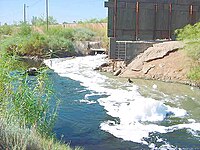
Photo from wikipedia
Silicated hydroxyapatite powders enriched with small amounts of manganese (Mn2+) cations were synthesized via two different methods: precipitation in aqueous solution and the solid-state method. The source of Mn2+ ions… Click to show full abstract
Silicated hydroxyapatite powders enriched with small amounts of manganese (Mn2+) cations were synthesized via two different methods: precipitation in aqueous solution and the solid-state method. The source of Mn2+ ions was manganese acetate, while silicon was incorporated using two different reagents: silicon acetate and sodium metasilicate. Powder X-ray diffraction (PXRD) analysis showed that the powders obtained via the precipitation method consisted of single-phase nanocrystalline hydroxyapatite. In contrast, samples obtained via the solid-state method were heterogenous and contaminated with other phases, (i.e., calcium oxide, calcium hydroxide, and silicocarnotite) arising during thermal treatment. The transmission electron microscope (TEM) images showed powders obtained via the precipitation method were nanosized and elongated, while solid-state synthesis produced spherical microcrystals. The phase identification was complemented by Fourier transform infrared spectroscopy (FTIR). An in-depth analysis via solid-state nuclear magnetic resonance (ssNMR) was carried out, using phosphorus 31P single-pulse Bloch decay (BD) (31P BD) and cross-polarization (CP) experiments from protons to silicon-29 nuclei (1H → 29Si CP). The elemental measurements carried out using wavelength-dispersive X-ray fluorescence (WD-XRF) showed that the efficiency of introducing manganese and silicon ions was between 45% and 95%, depending on the synthesis method and the reagents. Preliminary biological tests on the bacteria Allivibrio fisheri (Microtox®) and the protozoan Spirostomum ambiguum (Spirotox) showed no toxic effect in any of the samples. The obtained materials may find potential application in regenerative medicine, bone implantology, and orthopedics as bone substitutes or implant coatings.
Journal Title: Materials
Year Published: 2019
Link to full text (if available)
Share on Social Media: Sign Up to like & get
recommendations!